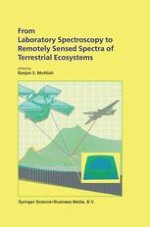2002 | OriginalPaper | Buchkapitel
Carbon Sequestration from Remotely-Sensed NDVI and Net Ecosystem Exchange
verfasst von : E. Raymond Hunt Jr., J. T. Fahnestock, Robert D. Kelly, Jeffrey M. Welker, William A. Reiners, William K. Smith
Erschienen in: From Laboratory Spectroscopy to Remotely Sensed Spectra of Terrestrial Ecosystems
Verlag: Springer Netherlands
Enthalten in: Professional Book Archive
Aktivieren Sie unsere intelligente Suche, um passende Fachinhalte oder Patente zu finden.
Wählen Sie Textabschnitte aus um mit Künstlicher Intelligenz passenden Patente zu finden. powered by
Markieren Sie Textabschnitte, um KI-gestützt weitere passende Inhalte zu finden. powered by
Aircraft eddy flux measurements of net ecosystem exchange were acquired in 1999 over four southeastern Wyoming landscapes: a coniferous forest, a mixed dryland/irrigated agricultural area, a mixed-grass prairie, and a sagebrush steppe. A linear relationship between net ecosystem exchange and the absorbed photosynthetically active radiation was used to determine the efficiency of radiation use, which was used with remotely-sensed normalized difference vegetation index to calculate gross primary production. Chamber measurements of total ecosystem respiration for the sagebrush and grassland sites were used to develop a functional relationship with daily average temperature. The sagebrush and forest sites were net carbon sinks, whereas the grassland and agricultural sites were in carbon balance. Combining the use of remote sensing with net ecosystem exchange measurements avoids problems associated with small-scale flux sampling to determine areas of carbon sequestration. With large areas of the globe covered by rangelands, the potential for carbon sequestration may be significant.
